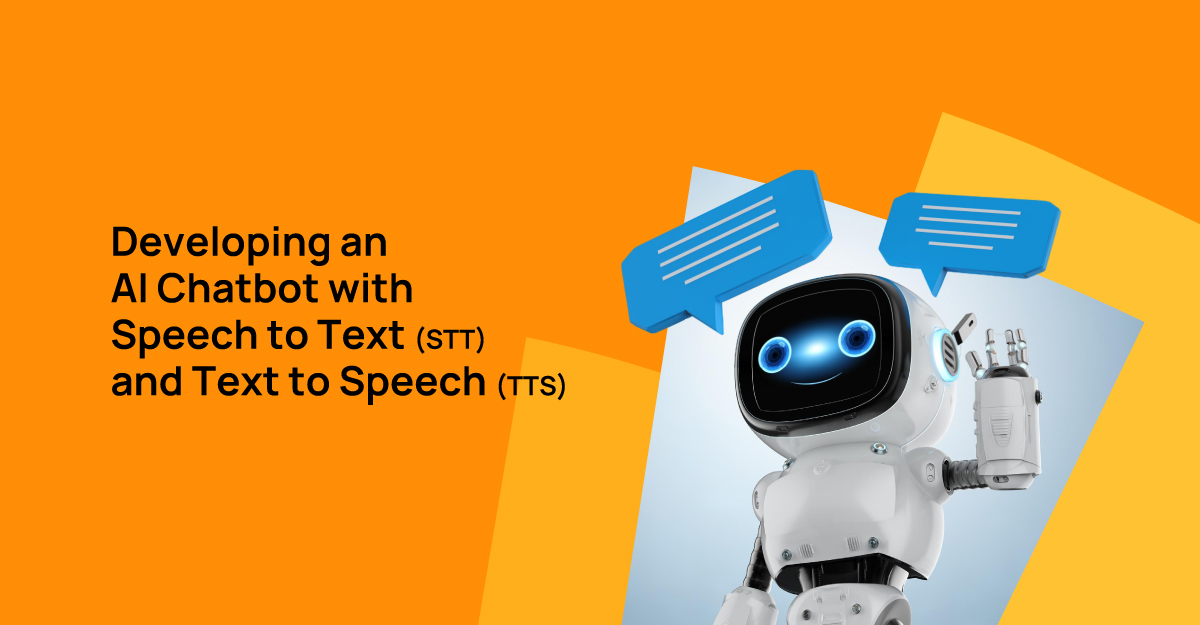Integrating Speech-to-Text (STT) and Text-to-Speech (TTS) technologies into AI chatbots has transformed user interaction, making it more intuitive and accessible. This blog will explore the development of an AI chatbot that leverages STT and TTS, analyzing their functionalities, benefits, and technical implementation using Node.js development services.
What is an AI Chatbot?
An AI chatbot is software designed for simulating conversations between human users especially on the Internet. These chatbots are made to get user’s queries and offer relevant responses owing to Natural Language Processing (NLP) and machine learning. The combination of STT and TTS improves these conversations where users can talk using their voices making it more interactive and faster.
The Expanding Landscape of TTS and STT
The TTS and STT technologies have grown widely today. From being initially applied in major virtual assistants like Siri and Alexa, today these technologies find applications in customer service, health, and education. Their ability to enable smooth communication makes them important tools in enhancing the user experience.
Developing Your AI Chatbot with STT and TTS
Creating an AI chatbot that incorporates STT and TTS involves several key components:
- Speech-to-Text (STT) Technology: Converts spoken language into text, enabling the chatbot to understand user commands and queries.
- Text-to-Speech (TTS) Technology: TTS converts text back into spoken language, allowing the chatbot to communicate responses audibly.
Speech-to-Text (STT) Technology
STT technology is crucial for converting spoken language into text. It works through various approaches, including:
- Speaker-dependent Systems: These require training on a specific user's voice, providing higher accuracy for that individual.
- Speaker-independent Systems: These do not require prior training and can recognize various voices, though they may be less accurate.
Text-to-Speech (TTS) Technology
TTS technology converts written text into spoken language. The quality of TTS systems is determined by the naturalness of the voices produced.
Importance of Natural-sounding Voices and Different TTS Approaches
Natural-sounding voices enhance user experience. Different TTS approaches include:
- Concatenative TTS: This method uses pre-recorded speech segments to create a natural-sounding voice.
- Parametric TTS: This approach generates speech using algorithms, allowing for more flexibility and customization.
Building a Multifunctional TTS and STT System with Node.js
A competent node.js development company can help with developing a multifunctional TTS and STT system due to its non-blocking architecture and extensive library support. Below is a step-by-step guide to building such a system.
Step 1: Set Up Your Development Environment
Begin by setting up your Node.js environment. Install the necessary packages:
npm install express google-text-to-speech @google-cloud/speech
Step 2: Create an Express Server
Set up an Express server to handle requests for TTS and STT functionalities.
const express = require('express');
const app = express();
const port = 3000;
app.listen(port, () => {
console.log(`Server running at http://localhost:${port}`);
});
Step 3: Implement Speech-to-Text Functionality
Use the Google Cloud Speech-to-Text API to convert audio input into text.
const speech = require('@google-cloud/speech');
const client = new speech.SpeechClient();
// Function to transcribe audio
async function transcribeAudio(audio) {
const request = {
audio: { content: audio },
config: {
encoding: 'LINEAR16',
sampleRateHertz: 16000,
languageCode: 'en-US',
},
};
const [response] = await client.recognize(request);
return response.results.map(result => result.alternatives[0].transcript).join('\n');
}
Step 4: Implement Text-to-Speech Functionality
Use the Google Cloud Text-to-Speech API to convert text responses into audio.
const textToSpeech = require('google-text-to-speech');
async function synthesizeSpeech(text) {
const audioContent = await textToSpeech.synthesize(text, { lang: 'en', slow: false });
return audioContent;
}
Step 5: Run Your Application
Run your Node.js server and test the functionalities.
node app.js
Your multifunctional TTS and STT system should now be accessible at http://localhost:3000.
What is Speech-to-Text (STT), and How Does It Intersect with Conversational AI?
STT is the process of converting spoken language into text, and it plays a critical role in conversational AI by enabling voice interactions. This technology allows users to communicate naturally, enhancing the overall user experience.
Top Benefits of Using STT to Build Conversational AI Tools
- Improved Accessibility: STT makes technology more accessible to users with disabilities.
- Enhanced User Engagement: Voice interactions can be more engaging than text-based communication.
- Faster Input: Users can speak faster than they can type, allowing for quicker interactions.
Advancements in STT Technology and Conversational AI
Recent advancements in deep learning and neural networks have significantly improved the accuracy and efficiency of STT systems, making them more reliable for conversational AI applications.
Leveraging STT and Conversational AI for Chatbots
Integrating STT with chatbots allows for more dynamic interactions, enabling users to engage in conversations without the need for typing.
What is Text-to-Speech (TTS), and How Does It Intersect with Conversational AI?
TTS technology converts written text into spoken language, playing a vital role in making chatbots more interactive and user-friendly.
Top Benefits of Using TTS to Build Conversational AI Tools
- Natural Interaction: TTS allows for more natural conversations, mimicking human-like dialogue.
- Multilingual Support: TTS can respond in various languages, broadening user reach.
- Enhanced User Experience: Users can receive information audibly, which can be more convenient in certain contexts.
Advancements in TTS Technology and Conversational AI
Advancements in TTS technology have led to more natural-sounding voices and improved emotional expression, enhancing user engagement.
Leveraging TTS and Conversational AI for Chatbots
By integrating TTS, chatbots can provide audible responses, making interactions more engaging and accessible.
Beyond Virtual Assistants: Applications of TTS and STT
TTS and STT technologies have applications beyond virtual assistants, including:
- Accessibility Features: Assisting users with disabilities.
- Language Translation: Facilitating real-time translation.
- Transcription Services: Converting spoken content into written form.
- Interactive Educational Tools: Enhancing learning experiences through voice interaction.
Considerations and Best Practices
When developing a TTS and STT system, consider the following best practices:
- Privacy Concerns: Implement robust measures to protect user data.
- Language Support: Ensure support for multiple languages and dialects.
- Real-time Processing: Optimize for minimal delays in user interactions.
- Scalability: Design systems to handle varying loads efficiently.
- User Feedback Integration: Continuously improve systems based on user feedback.
Choose a Next-Gen Platform to Build Next-Level Conversational AI
Selecting the right platform for your TTS and STT implementation is crucial. Consider platforms that offer robust APIs, scalability, and support for various languages.
Conclusion
AI chatbots integrate speech-to-text and text-to-speech technologies to innovate user interactions. These technologies can be used to make conversational AI tools more engaging, accessible, and efficient for developers. As new developments continue to appear, the potential uses for STT and TTS are only going to expand, opening up increasing space in the future for innovative solutions.



